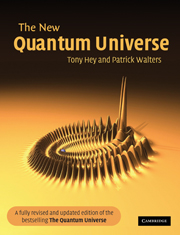Book contents
- Frontmatter
- Contents
- Preface
- Prologue
- Route map
- 1 Waves versus particles
- 2 Heisenberg and uncertainty
- 3 Schrödinger and matter waves
- 4 Atoms and nuclei
- 5 Quantum tunnelling
- 6 Pauli and the elements
- 7 Quantum co-operation and superfluids
- 8 Quantum jumps
- 9 Quantum engineering
- 10 Death of a star
- 11 Feynman rules
- 12 Weak photons and strong glue
- 13 Afterword – quantum physics and science fiction
- Epilogue
- Appendix 1 The size of things
- Appendix 2 Solving the Schrödinger equation
- Glossary
- Quotations and sources
- Suggestions for further reading
- Photo-credits
- Name index
- Subject index
2 - Heisenberg and uncertainty
Published online by Cambridge University Press: 05 October 2013
- Frontmatter
- Contents
- Preface
- Prologue
- Route map
- 1 Waves versus particles
- 2 Heisenberg and uncertainty
- 3 Schrödinger and matter waves
- 4 Atoms and nuclei
- 5 Quantum tunnelling
- 6 Pauli and the elements
- 7 Quantum co-operation and superfluids
- 8 Quantum jumps
- 9 Quantum engineering
- 10 Death of a star
- 11 Feynman rules
- 12 Weak photons and strong glue
- 13 Afterword – quantum physics and science fiction
- Epilogue
- Appendix 1 The size of things
- Appendix 2 Solving the Schrödinger equation
- Glossary
- Quotations and sources
- Suggestions for further reading
- Photo-credits
- Name index
- Subject index
Summary
A philosopher once said ‘It is necessary for the very existence of science that the same conditions always produce the same results’. Well, they don't!
Richard FeynmanWatching electrons
We have seen that quantum mechanics does not allow us the comfort of being able to visualize the motion of a quantum particle. In a normal game of billiards we can imagine the paths taken by the individual balls (Fig. 1.1). Figure 2.1 shows the physicist George Gamow's attempt to give some impression of how the same game might look if played with quantum particles. Besides illustrating that the notion of a path is no longer valid in quantum mechanics, this cartoon also illustrates another significant difference between the quantum and classical worlds: the exact position of the white ball is not known. Uncertainty has entered physics and replaced the determinism of Newtonian mechanics.
By the nineteenth century, physicists had been able to explain vast amounts of experimental observations on objects as different as planets and billiard balls. If an observation differed from the predictions of classical physics, they looked for something they had overlooked to explain the deviation. In 1864, physicists' confidence in the whole edifice of classical physics seemed to be spectacularly verified by an analysis of some irregularities in the orbit of Uranus. These were attributed to the existence of a then undiscovered planet – the subsequent discovery of Neptune was a triumph for Newtonian physics.
- Type
- Chapter
- Information
- The New Quantum Universe , pp. 17 - 34Publisher: Cambridge University PressPrint publication year: 2003



